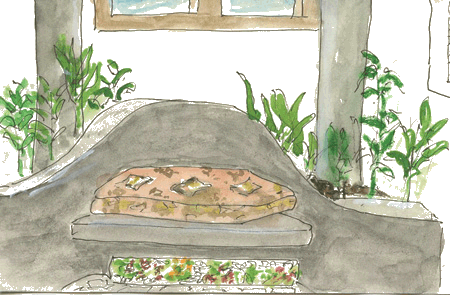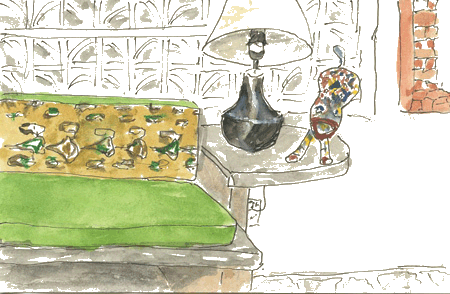La Manzanilla, Jalisco, Mexico — February 2014
La Manzanilla is a small fishing village in the southeastern corner of the Bay of Tenacatita, in the Mexican state of Jalisco. Manzanilla is both a tree used for boat-building and a bush from which chamomile tea is made. The village and surrounding area were once part of a large privately-owned hacienda. Following the Mexican Revolution, the land was distributed to locals, and land claims are still in dispute.
The town is chock full of expats, mostly Canadians escaping the cold and ice of the long northern winter. Many built modern homes in town. It is one of the friendliest places in North America. Everyone greets people on the street, including visitors like us, and offers directions and assistance. There is a strong culture of hospitality and service. One does not avoid eye contact with strangers in the street or on the beach. Expats volunteer in the library, tutor in the schools, pick up trash in town and on the 6-mile beach, neuter cats and dogs, and organize clubs and cultural events. While we were there, an online auction was held to support local schools.
Casa Bambu, named for the exterior and interior decor is an architect-designed house on a steep hill about 6 blocks from the beach. We rented it for a week through Airbnb. There are four residential levels, five if you count the basement storage room and garage.
|
|
 |
 We were on interior level 1, and our friends Jim and Pat were on level 3. This is our sleeping area. We were on interior level 1, and our friends Jim and Pat were on level 3. This is our sleeping area. |
 |

Level 1 seating areas.
|
 |
 Stairway between interior levels 1 and 2 Stairway between interior levels 1 and 2 |

The livingroom, kitchen and food storage areas were on level 2 (with a second smaller kitchen on level 4).
|

Colorful Mexican arts and crafts filled every room. |
|
As our house was above the town, all the sounds drifted up through open windows. On weekdays there was a cycle of street sounds— crowing roosters, barking dogs, church bells summoning worshippers to mass (bells tolling, then one bell for first call). About 5 minutes later, more bells following by two bells (second call). Then school children reciting lessons and playing in the yard, school announcements (delivered by loudspeaker), delivery trucks each with a distinctive ring, insistent long-tailed blackbirds, and garage bands playing into the night. Things quieted down after the bands gave up for the night.
Saturday morning was quiet as there were no school sounds to waken the dogs, only a few crowing roosters in the distance, and nearby squawking birds.
|
|
| Among the interesting decorations were painted tree pods with seeds inside. They were called Tabachins after the tree species. Sold at the tianguis (weekly craft market), Barbara bought one to take home and another for our neighbor. To round out the craft/art cycle, Bob painted five of the colorful pod creatures. |
 |
 |
|
|
 |

There was an impromptu open-air market set up in the central plaza. Bicycles, motor scooters, and dune buggies were in abundance. There were no large hotels or stores, no bank nor ATM. To obtain pesos we had to take the bus to Melaque, about 10 miles up
the coast.
|

Church plaza
|

View from Casa Bambu looking past drop-down bamboo shade
|

Jungle across the ravine, towards the ocean.
|
 Walking down the steep hill into town was as difficult as walking up. Happily, Mazanilla is pedestrian-friendly. Cars are few and there were speed bumps (topos) every few blocks so vehicles drove slowly. Tope Dog himself at the base of our hill, so named (by us) because he napped in the middle of the street, slowing down traffic. Walking down the steep hill into town was as difficult as walking up. Happily, Mazanilla is pedestrian-friendly. Cars are few and there were speed bumps (topos) every few blocks so vehicles drove slowly. Tope Dog himself at the base of our hill, so named (by us) because he napped in the middle of the street, slowing down traffic. |
 |

Neighboring homes
|
 |
 |
We spent a lot of time walking the long curved uncrowded beach. The water was warm and we swam when and where we wanted. We watched flocks of gulls and pelicans diving for fish in the shallows, the surf exploding with every dive; large frigate birds circled above waiting to steal a meal. Fisherman competed with the birds for the silvery dorado; expats used poles and spinning reels, locals had nets and line wrapped around circular containers. 
There were few tourist attractions as such. We did go on a four-hour whale watching expedition. There were two crew (including Arturo the skipper) and nine passengers, all of whom were given orange life vests and Bushnell field glasses. Our first hour on the water was fruitless, motoring back and forth questioning crews on passing fishing boats for whale locations. |

| Finally we connected with a whale pod and they were everywhere after that. We saw them breaching and crashing down into the waves, spouting, diving (we were told that they have to surface for breathing every 40 minutes), and mother whales accompanied by their young. By law, boats must remain 50 meters from the whales they are observing, but the whales are on the move, and often come closer than that. |
|

We ate seafood in the palapa restaurants, mostly shrimp and fish fillets, washed down by margaritas and good Mexican beer. Margaritas were the same price as a glass of wine. There were take-out places selling carnitas on plates with fresh tortillas and rice to take back home. Restaurant service is leisurely; no one rushes. Waitpeople ask where you are from and describe their connection to the United States. All have family in the US and there is a lot of travel back and forth across the border. On the shoreline, restaurants jut out onto the beach. Tables and chairs nearest the water are unstable. Tables tilt in the sand and chairs tip over.
|
 |
 |
 We visited the large crocodile reserve, set aside by the government for more than 300 crocs. If there been more time, we would have taken the early morning boat tour through the shallow mangrove swamp to see the profusion and variety of birds. Observing the many sleeping crocodiles was not very exciting; most had their eyes shut and stayed fixed in place or moved silently under water. We visited the large crocodile reserve, set aside by the government for more than 300 crocs. If there been more time, we would have taken the early morning boat tour through the shallow mangrove swamp to see the profusion and variety of birds. Observing the many sleeping crocodiles was not very exciting; most had their eyes shut and stayed fixed in place or moved silently under water. |

Salsas
|

Restaurante in Melaque (bigotes = mustache)
|

There is a fair amount of new construction. We were told there is court case involving property to the north that will be developed if title can be cleared. However, this looks like a town that has some very committed residents. We’re guessing that there will be forces to help preserve its present ambiance.
|
Absent in Manzanilla
Graffiti
Gang or drug violence
Police on the street
Guns
Beggars
Street people
Trash
Burning piles of plastic
Franchises and chains
(all the stores were mom-and-pop operations) |
|